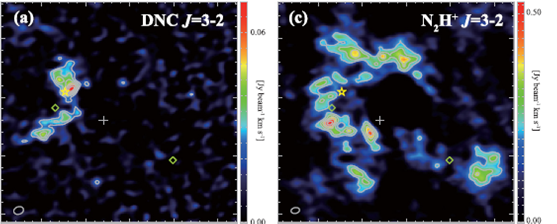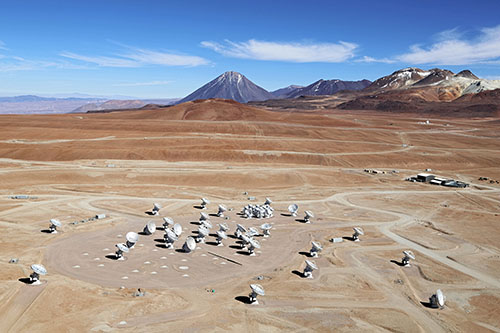June 2015 Issue
Research Highlights
Star formation: Exotic chemistry
Stars are born in the dense and cold regions of the interstellar medium, where the conditions are just right for the formation of the first very simple and slightly more complex molecules. These stellar nurseries are called molecular clouds and the chemical reactions that take place there are key to the early stages in star formation. To understand this exotic astrochemistry Takeshi Sakai and collaborators in Japan and the US used the data from Atacama Large Millimeter/submillimeter Array (ALMA) to look at the spectral lines of certain molecules that provide clues about the physical conditions in the active star-forming regions just before star birth.
The deuterated hydrogen isocyanide to hydrogen isocyanide (DNC/HNC) abundance ratio remains almost the same even after the star is born providing information about the conditions in the pre-stellar phase. Previous single-dish telescope observations had shown unexpectedly low DNC/HNC ratios so Sakai and collaborators chose an infrared dark cloud with the lowest reported ratio to study with the enhanced resolution of ALMA.
Sakai and colleagues found that the emission of hydrogen isocyanide comes from the hot core of the region, whereas the deuterated hydrogen isocyanide emission is stronger and extends around the core. And the protonated nitrogen emission is weaker near the core, so all these signals trace the warm regions near protostars quite differently.
The team also found that the DNC/HNC ratio depends strongly on the density which explains why the ALMA DNC/HNC ratio was different from the single-dish one, single-dish telescopes having low filling factor for the high density regions. So these new results not only shed light on the relationship between the DNC/HNC abundance ratio and star formation, but also on previous observations.
Publication and Affiliation
Takeshi Sakai1, Nami Sakai2, Kenji Furuya3, Yuri Aikawa4, Tomoya Hirota5,6, Jonathan B. Foster7, Patricio Sanhueza5, James M. Jackson8, and Satoshi Yamamoto2 ALMA observations of the IRDC clump G34.43+00.24 MM3: DNC/HNC ratio, The Astrophysical Journal, 803:70 (2015).
- Graduate School of Informatics and Engineering, The University of Electro-Communications, Chofu, Tokyo 182-8585, Japan
- Department of Physics, Graduate School of Science, The University of Tokyo, Tokyo 113-0033, Japan
- Leiden Observatory, Leiden University, P.O. Box 9513, 2300 RA Leiden, The Netherlands
- Department of Earth and Planetary Sciences, Kobe University, Kobe 657-8501, Japan
- National Astronomical Observatory of Japan, Osawa, Mitaka, Tokyo 181-8588, Japan
- Department of Astronomical Sciences, Graduate University for Advanced Studies, Mitaka, Tokyo 181-8588, Japan
- Yale Center for Astronomy and Astrophysics, Yale University, New Haven, CT 06520, USA
- Institute for Astrophysical Research, Boston University, Boston, MA 02215, USA


(Credit: Clem & Adri Bacri-Normier (wingsforscience.com)/ESO)


